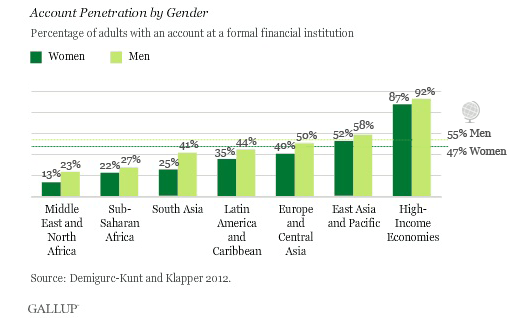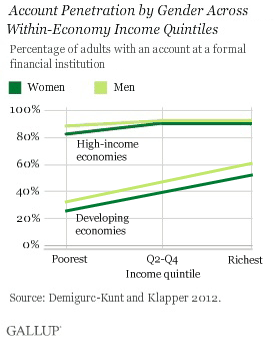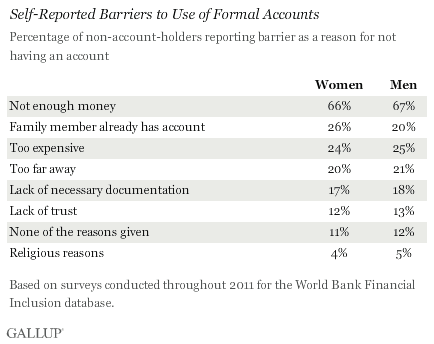This article is part of an ongoing series on global financial inclusion based on data collected for the new World Bank Global Financial Inclusion (Global Findex) database.
WASHINGTON, D.C. -- Worldwide, 55% of men and 47% of women have a bank account at a formal financial institution, according to a recent Gallup/World Bank study. Gender gaps like this exist in all regions, but women in South Asia and the Middle East and North Africa are among the most likely worldwide to trail men terms of having a formal bank account.

Divides such as these underscore the need for timely, high-quality data to evaluate and strengthen public policies aimed at improving women's lives, the focus of an event last week at Gallup that featured remarks from U.S. Secretary of State Hillary Clinton and World Bank President Jim Yong Kim.
These results come from a global study of financial inclusion, which measures how adults in 148 economies save, borrow, make payments, and manage risk. Gallup collected the data in 2011 for the World Bank Global Financial Inclusion (Global Findex) database, which is funded by the Bill & Melinda Gates Foundation. The database is the first source of hard data for examining how women make financial transactions, both inside and outside the formal financial sector.
Gender Gap Evident Across Income Groups
The gender gap in account penetration is larger in the developing world (nine percentage points) than in high-income economies (five points). It is larger still among adults living on less than $2 a day. In this group, women are 28 percentage points less likely than men to have a formal account.

The gender gap persists across income groups within economies as well. In the developing world, there is a constant gap of six to nine points across within-economy income quintiles. Even among the richest 20% of earners within developing economies, the gender gap in the ownership of formal accounts averages nine points.
Many Women Unbanked Because Family Members Already Have Accounts
Among all adults without an account, the most common reason cited for not having one was not having enough money to use an account. Among unbanked men, the next most commonly cited reason was that banks or accounts are too expensive. However, among unbanked women, the second most common reason (cited by 26%) is that another family member already has an account. For men, this reason ranks fourth (after too expensive and too far away).

In South Asia, where the overall gender gap in account penetration is largest, the gender gap in this response is 10 percentage points. This suggests that indirect use of accounts is widespread among women in the region -- reflecting a lack of asset ownership that may have implications for economic independence and self-employment opportunities.
Community-Based Saving Is Widespread in Africa
Beyond account penetration, the Global Findex database reveals interesting patterns in how women manage day-to-day financial transactions. In sub-Saharan Africa, for example, 20% of women use an informal community-based savings method such as a rotating savings and credit association (ROSCA). And there appears to be a significant gender gap in the use of these methods. In Central African countries, for example, 39% of women who save report doing so through a community-based method, not a bank. This is the case for 27% of men.
The widespread use of community-based savings clubs speaks to their popularity, but a downside is the risk of fraud and theft. The commitment to regular saving by the many users of these "semiformal" products may suggest a missed opportunity to provide safe, affordable financial products to people without formal accounts. The Global Findex data suggest that one key to expanding financial inclusion is new products and technology -- such as mobile banking -- that can move past the traditional brick-and-mortar business models to provide affordable and accessible banking services.
Bottom Line
For decades, researchers and policymakers have struggled to pinpoint the barriers women face to financial access. The Global Findex data allow us to see how women themselves explain their financial exclusion. All policy discussions should be rooted in sound data and the ongoing debates in the world of financial inclusion are no exception -- whether the focus is on ways to close the gender gap, the expansion of rural credit cooperatives, or the spread of bank agents.
Leora Klapper is the lead economist on the Finance and Private Sector Research Team for the World Bank's Development Research Group.
The complete database and related report, along with the survey in 15 languages, are available at globalfindex.worldbank.org.
Access the complete country-level data set, report, and questionnaire at globalfindex.worldbank.org.
For complete data sets or custom research from the more than 150 countries Gallup continually surveys, please contact SocialandEconomicAnalysis@gallup.com or call 202.715.3030.
Survey Methods
Results are based on face-to-face and telephone interviews with approximately 1,000 adults per country, aged 15 and older, conducted in 2011 in 148 countries. For results based on the total samples, one can say with 95% confidence that the maximum margin of sampling error ranges from ±2 percentage points to ±5.1 percentage points.
The World Bank defines high-income economies as those with a GNI per capita of $12,276 or more.
For more complete methodology and specific survey dates, please review Gallup's Country Data Set details.
